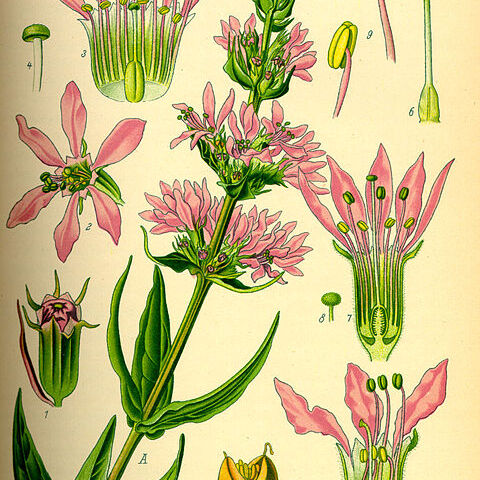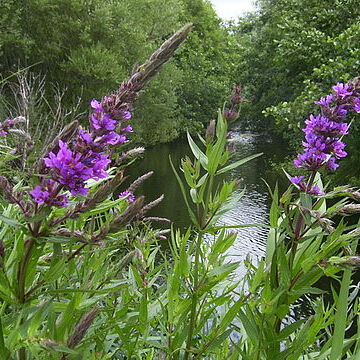Mostly annual or perennial herbs, sometimes small shrubs; stems often quadrangular, especially when young. Lvs opposite, sometimes alternate or whorled, entire. Fls (4)-6-(8)-merous, actinomorphic, often di-or tristylous, usually solitary in upper lf axils, sometimes in small whorled cymes which may form terminal spikes; bracteoles 2. Calyx tube straight, usually tubular, occasionally broad-campanulate, not spurred or pouched at base; epicalyx present. Petals 4-6, usually conspicuous, occasionally inconspicuous or 0, clawed, usually purplish, inserted in lower part of calyx tube. Stamens 2-12, sometimes in 2 series of different lengths. Ovary sessile or nearly so, 2-celled; stigma capitate; ovules 2-numerous in each cell. Capsule enclosed by calyx, septicidal with 2 valves or dehiscing irregularly.
Perennial or annual herbs, rarely subshrubby. Leaves decussate, verticillate or alternate. Flowers 4–6(–8)-merous, regular or obscurely irregular, often di-or trimorphic, axillary, solitary or in cymes, sometimes congested into raceme-like “terminal” inflorescences. Calyx tubular or ± campanulate, the sinus-appendages obvious or ± obsolete. Petals mostly conspicuous, rarely lacking. Stamens (1–)4–12, inserted near base of tube, some or all exserted, the ventrals and dorsals often inserted at different heights. Ovary ± sessile, oblong or ovoid, incompletely bilocular; ovules numerous; style usually well developed, rarely almost lacking; stigma capitate. Capsule 2-valved; valves sometimes ± bilobed, membranous to ± coriaceous. Seeds 8 to numerous.
Fls 6-merous, often dimorphic or trimorphic as to the style and stamens; hypanthium cylindric or narrowly campanulate, 8–12-nerved; sep short, alternating with appendages in the sinuses; pet red-purple to white; stamens (4–)6 or 12; ovary bilocular, with or without a disk; style slender; capsule septicidal or septifragal, enclosed by the persistent hypanthium; herbs or shrubs, usually virgately branched, with opposite, alternate, or whorled lvs and numerous bibracteolate fls sessile in the axils or in small cymes aggregated into a terminal spike-like thyrse. 30, ± cosmopolitan.
Herbs or subshrubs, annual or perennial. Leaves alternate, opposite or in whorls of 3, sessile or subsessile; stipules absent. Flowers axillary, solitary, few-flowered dichasia or clustered, regular, 4-6-merous. Hypanthium elongate-tubular, ribbed; appendages present, elongate. Petals obscure to showy, unclawed. Stamens equal to and opposite sepals or twice as many as sepals. Ovary 2-locular; style filiform. Capsule enclosed in persistent hypanthium; dehiscence usually septicidal.


